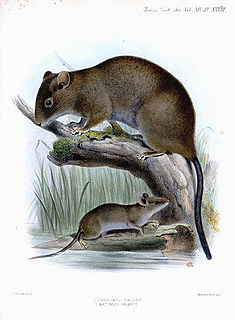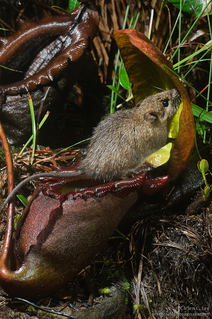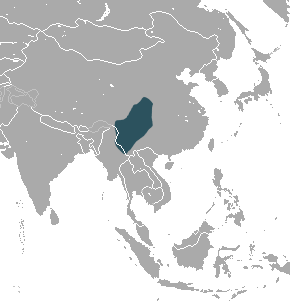
The snowcocks or snowfowl are a group of bird species in the genus Tetraogallus of the pheasant family, Phasianidae. They are ground-nesting birds that breed in the mountain ranges of southern Eurasia from the Caucasus to the Himalayas and western China. Some of the species have been introduced into the United States. Snowcocks feed mainly on plant material.

The eastern gorilla is a critically endangered species of the genus Gorilla and the largest living primate. At present, the species is subdivided into two subspecies. The eastern lowland gorilla or Grauer’s gorilla is more populous, at about 3,800 individuals. The mountain gorilla has only about 1,000 individuals. The International Union for Conservation of Nature mentioned illegal hunting in its assessment of threats to the species.

Anaspididae is a family of freshwater crustacean that is endemic to Tasmania, Australia. The family contains 3 genera and 5 species. This group of crustaceans are considered living fossils. They are commonly and collectively known as the Tasmanian anaspid crustaceans. Anaspidids have stalked eyes, long antennae and antennules, and a slender body with no carapace. The two species of Allanaspides and the single species of Paranaspides are all listed as vulnerable on the IUCN Red List.

A species that is extinct in the wild (EW) is one that has been categorized by the International Union for Conservation of Nature as known only by living members kept in captivity or as a naturalized population outside its historic range due to massive habitat loss.

The Luzon forest rat or Luzon hairy-tailed rat is one of five species of rodent in the genus Batomys. It is in the diverse family Muridae. This species is found only in the Philippines. This species was the first of the five to be identified and stayed the sole indicator for the genus for roughly 75 years, until 1988. Majority of this species lives on Mount Data which is one of several mountains in the Cordillera Mountains region of Northern Luzon.

The summit rat is a species of rodent in the family Muridae. It is found only on Mount Kinabalu and Mount Tambuyukon, Malaysia, and has been recorded at altitudes of 2,040 to 2,477 m on Mt. Tambuyukon and 2,670 to 3,426 m on Mt. Kinabalu. They are most abundant in higher altitude dwarf forest and montane scrubland. The rat populations from these two peaks were connected in the Holocene. However, nowadays they are genetically isolated despite they are only 18 km apart. With current predictions of Global warming, the suitable habitat for Rattus baluensis is expected to shift around 500 m upwards. This will put the population in Mount Tambuyukon at risk. However, the population in Mount Kinabalu will likely survive in its upper slopes. Genetic analysis situate its origin in a local population of Rattus tiomanicus from northern Borneo at around 300-400 thousand years ago.
Hoogerwerf's rat is a species of rodent in the family Muridae. It is named after zoologist Andries Hoogerwerf and is found only in western Sumatra, Indonesia, including Mount Leuser, where it is found only above 2000 m. It is known from few museum specimens. Genetic analysis indicate its closest relative is Rattus korinchi, another Sumatran mountain rat from which it diverged around 1.4 million years ago.

Goodwin's broad-clawed shrew is a species of mammal in the shrew family, Soricidae. Body length and size of adults average 9.49 cm and 7.0 grams respectively making it a relatively larger shew. What distinguishes this from other shrews are its long claws.

The Japanese mountain mole is a species of Old World mole in the family Talpidae. It is endemic to Japan. It is the only member of the monotypic genus Oreoscaptor. Its natural habitats are temperate forests and temperate grassland.

The long-tailed mountain shrew is a species of mammal in the family Soricidae. It is found in China, Myanmar, Nepal, and Vietnam.

The gracile shrew mole is a species of mammal in the family Talpidae. It is endemic to China; populations known from Myanmar likely represent other species.
Aquadulcaris is a genus of crustaceans in the family Paramelitidae, containing the following species:

A vulnerable species is a species which has been categorized by the International Union for Conservation of Nature that is threatened with extinction unless the circumstances that are threatening its survival and reproduction improve.

The New Mexico shrew is a species of mammal in the family Soricidae. It is found only in New Mexico in the Capitan and Sandia-Manzano Mountains. Its total length is 103 to 121 millimeters. Its tail length is 39 to 54 millimeters. It weighs 6 to 8 grams. It was included in Sorex monticolus until 1996. It is distinguished from Sorex monticolus by its teeth. The row of unicuspid teeth is longer in Sorex neomexicanus than in Sorex monticolus, and Sorex neomexicanus has a wider space between its first upper unicuspid and second upper unicuspid than Sorex monticolus does.

Endangered species as classified by the International Union for Conservation of Nature (IUCN), are species which have been categorized as very likely to become extinct in the near future. On the IUCN Red List, endangered is the second most severe conservation status for wild populations in the IUCN's schema after Critically endangered (CR). In 2012, the IUCN Red List featured 3,079 animal and 2,655 plant species as endangered (EN) worldwide. The figures for 1998 were 1,102 and 1,197 respectively.











